Theme Parks & Themed Entertainment
Is Brad Bird’s “Tomorrowland” movie about that “UFOs are real” TV show which Walt Disney Productions almost made back in the 1950s?

For three weeks now,
photos of a mysterious bankers box have been making the rounds on the Web. Brad
Bird and Damon Lindelof reportedly deliberately put these images out there to
help whet people’s appetites for “Tomorrowland,” the sci-fi -themed
project that these two wrote which is based on a concept that Lindelof and
“Entertainment Weekly” writer Jeff Jensen originally came up with.
“So what’s this motion picture actually supposed to be
about?,” you ask. Well, as Matthew Jackson recounted in his October 2012 article for
Blastr, “Tomorrowland” ‘s origin can be traced back to …
… a 2011 meeting between Lindelof and Disney exec Sean Bailey.
During that meeting, Bailey apparently brought out a box dating back to the
days of WED Enterprises, Walt Disney’s personal development lab that later gave
birth to Disney’s “Imagineers.” The box was originally labeled
“That Darn Cat
,” but had been relabeled “1952.” Inside were
materials related to some long since abandoned Disney project (maybe a movie,
maybe a ride) about aliens.
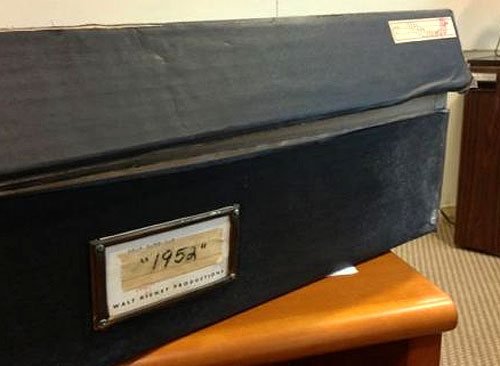
Copyright Disney Enterprises, Inc. All rights reserved
Earlier this week over on the D23 website, Walt Disney
Archives director Becky Cline took a closer look at that photograph of the
contents of this box which Brad & Damon had put out there. And she then
identified several specific items which I’ve highlighted below:
- On the top there are some old photos. The three that I can
see are of Walt with visitors, probably taken here at the studio. The one on
top is in our photo collection and I was able to identify the man with him as
Major Woodlief of the U.S. Army Reserve General Fund. It was taken in September
1943.
- There is a blue paperback book in the box.
- The magazine that appears along with this curious collection
of documents and objects provides more clues. It is a copy of the science
fiction magazine Amazing Stories from August 1928.
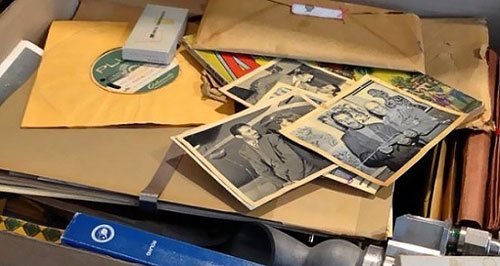
Copyright Disney Enterprises, Inc. All rights reserved
- There are two slide boxes in the box, one features the
Technicolor logo; the writing on the other white slide box is indecipherable.
- There is a 45 rpm record that appears to be a master disc.
It is probably from the ’40s or early ’50s (these type of records pre-date
magnetic tape recording). It’s definitely not the kind of record that is
pressed and sold to the public. Unfortunately, its handwritten label is too
blurry to decipher.
So let’s review those clues again. We have a picture of Walt
Disney meeting with a senior U.S. military official. We have a blue book. We have a
science fiction magazine entitled “Amazing Stories.” And we have a
mystery box with a “1952” label stuck on its side that’s filled with
photographs & recordings from the late 1940s / early 1950s.

Copyright Disney Enterprises, Inc. All rights reserved
To borrow a phrase that’s heard most every night on
“Wheel of Fortune,” “I’d like to solve the puzzle, Pat.”
Based on the evidence in this photograph as well as info that has previously
leaked out about this Brad Bird / Damon Lindelof project, I believe that
“Tomorrowland” has something to do with Project Blue Book, the program that the U.S. Air Force launched in late 1952 / early 1953 for the investigation of unidentified flying objects.
And to now get really, really specific here, I believe that
this upcoming Walt Disney Pictures release (which is due to hit theaters on
December 19, 2014) uses a behind-the-scenes story that the late Ward
Kimball loved to tell as its jumping-off point. Where — during the mid-1950s
— the U.S.
government supposedly approached Walt Disney and then asked for his help in
producing a TV show that would eventually be used to break the news to the
American public that UFOS are real.
Which — I know — sounds kind of bizarre. But you have to
remember that — back during World War II — Walt Disney Studios made all sorts
of training films for the U.S.
military. And many of these movies made use of classified
material. And given the care & discretion that Disney staffers had shown
while working on these super-secret training films … Well, it would only
stand to reason that — were military officials looking for someone in
Hollywood to help produce a television program of a highly sensitive nature
which would then have to be shot in utter secrecy … Given that the brass at
the Pentagon already had this history / working relationship with Walt, it would only make
sense that they’d reach out to Walt Disney Productions when it came to a
super-secret project like this.
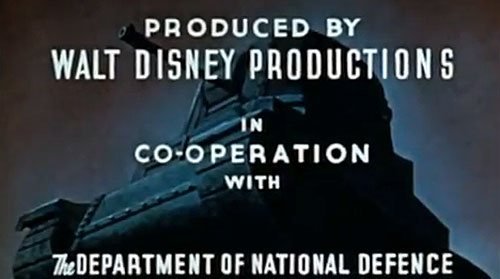
Copyright Disney Enterprises, Inc. All rights reserved
I know, I know. This all sounds rather far fetched. But you
have to understand — when it comes to the really-for-real history of The Walt
Disney Company during the mid-1950s — truth is often stranger than fiction.
Take — for example — the stories that Ward Kimball used to tell about his
interaction with senior military officials while he was working on those
“Man in Space” episodes
for the “Disneyland”
TV series.
FYI: If you’d like to read an exact transcript of this
UFO-related, you can find it in Volume 11
of
“Walt’s People.” Which
is Didier Ghez‘s excellent series of books which has made hundreds of rare
interviews with Disney Legends available to the general public to read.
Anyway … The interview that we’re talking about today was
done by noted animation historian John Canemaker. And as Ward was talking with
John, Kimball recalled the time when he was working with German-American rocket
scientist Wernher von Braun on three space travel-themed episodes of the “Disneyland”
television series. Which — just to re-enforce the connective tissue here
between the way-out story that Ward loved to tell and the film that Brad &
Damon are now making — that trio of episodes (i.e. “Man in Space,”
“Man and the Moon” and “Mars and Beyond”) — were initially
presented to the public under that TV show’s “Tomorrowland” banner.
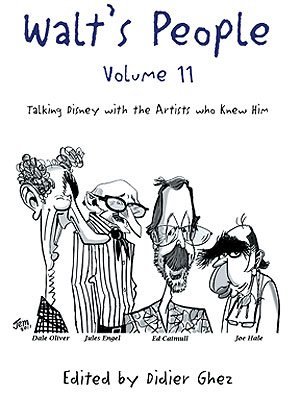
Copyright 2012 Xlibris Corp. All rights reserved
When “Man in Space” — the first of these
Tomorrowland inspired episodes — aired on ABC back in March of 1955, it racked
up enormous ratings. Over 42 million people tuned in to watch this speculative documentary about how man might
eventually travel into space. In fact, to hear some members of the Eisenhower
administration talk, this particular episode of the “Disneyland”
television show actually played a key role in America’s
decision to finally enter the space race.
Anywho … Getting back now to those ridiculously high ratings that the initial airing of
“Man in Space” racked up. As Kimball
recounted to Canemaker, this …
… did not go unnoticed by Al Meyers and (Edward)
Heinemann, two big shots in Douglas Aircraft, plus George Hoover, who was head
of the office of naval research. (They) came to me and wanted Disney to do a UFO
picture.
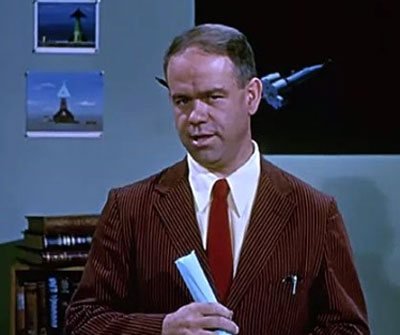
Ward Kimball introducing the “Man in Space” episode of the
“Disneyland” TV show. Copyright Disney Enterprises, Inc.
All rights reserved
(These three) all knew that UFOs were for real. They had
proof, they had everything. And I said, “Sure.” I’d been collecting
material on UFOs for years anyway, and I had a cupboard full of stuff there.
Every report and all the books, you name it. I was a student of Charles Fort,
and that was my dream to end the (“Disneyland”
television series of outer space documentaries) with (a fourth film about
UFOs).
Walt sort of went along with it. But we never had any payoff
footage. You’ve got to end up that last ten minutes with some real stuff.
Our disappointment came when we talked to Colonel Miranda
from the Wright-Patterson [Air Force Base]. Bill Bosché (i.e. the writer that
Walt had assigned to work with Ward on these outer space documentaries for the
“Disneyland” television series) never believed in UFOs even though
Clyde Tombaugh, the guy that discovered the planet Pluto, had seen four or five
in Arizona …
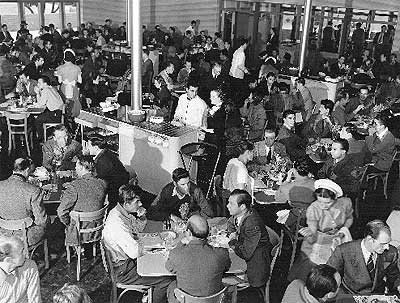
The commissary at Walt Disney Studios in the late 1940s / early
1950s. Copyright Disney Enterprises, Inc. All rights reserved
So we’re having lunch with this Colonel Miranda over in the
commissary, and he, at Wright-Patterson, had all the footage shot from fighter
pilots, everything, and most of it classified. He told us what we could have
for our picture and what we couldn’t have.
And so Bosché … He gets a smile on his face and he says,
“What about flying saucers? I don’t suppose you have anything on
that?” (And then Miranda replies by
saying) “Oh, hundreds of feet!” (And) Old Bosché looked like he’d
faint.
(The Colonel continues by saying) “We’ve got all sorts
of film that we can’t show you, it’s secret, and it’s going to remain
classified until we can take one apart and analyze it.”
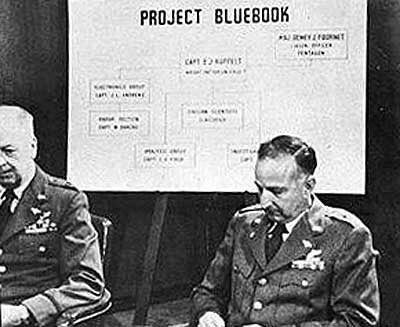
File photograph from one of Project Blue Book’s public meetings
And he [Bosché] says, “Well, how come?” And that’s
when (Miranda) taught us our lesson, he says, “Look! Everyone would ask
the Air Force, ‘What are these things?’ And if we couldn’t answer that
question, we would be in trouble. We could have a war start. They would accuse
the Russians of doing it, they’re ahead of us.” He went through a whole
line of reasons why this couldn’t be divulged.
(Which was endlessly frustrating for Kimball. Especially since
the Colonel then went on to say that)
“We have shots (of UFOS) taken from gun cameras, we have beautiful
footage. We’ve got ’em all shapes and size, port holes, lights … (But) We don’t know what they are yet. Until
we can dissect (one), and give a reasonable explanation without our society
coming unglued, we can’t. It’s going to remain classified.”
Which kind of drove Kimball nuts. Given that Ward had
already done a lot of the research necessary for this proposed fourth outer space
documentary for the “Disneyland” TV
series. As Kimball recalled to
Canemaker:

Do these Egyptian hieroglyphics depict unidentified flying objects?
And I had everything up to the last ten minutes (of that
show) … We had these drawings that people have made (of) the spaceships that had passed for a good
part of a day over the Egyptian army in Egypt in 2000 B.C. They described the
stench and the fumes, the whole thing; it was even done in hieroglyphics. We
wanted to bring that to life (through animation). Great thing, you know.
Pictorially, it (would have been) a wonderful
thing to do.
But without the last 10 minutes of that show, which was to
have featured the Air Force’s footage proving that UFOs were in fact real …
This proposed fourth installment of the outer space documentary series just had
no pay-off.
So what if the contents of this “1952” box that
we’ve all seen around the Web over the past three weeks was all of that
research material which Ward supposedly pulled together for this never-produced
fourth “Man in Space” episode? And what if someone working at Walt
Disney Studios today were to have suddenly come across this stuff? A box full
of slides & recordings which proved that the Company had, back in the 1950s, almost made a television show that would have proven to the American people that
UFOs are real? Wouldn’t that be a great MacGuffin to build a motion picture
around?
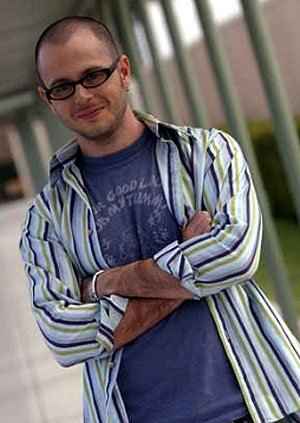
“Tomorrowland” writer / producer Damon Lindelof
There’s only one problem with this theory. Given the numerous questions that Damon
Lindelof had been getting about the mysterious contents of this
“1952” box and what they all might possibly mean, he took to Twitter
back on January 28th to say:
[Brad and I] won’t tell you what [our movie is] about (yet),
but we will tell you what it’s NOT about. And that would be ALIENS.
#Tomorrowland
Of course, if “Tomorrowland” does in fact touch on
the history of Project Blue Book (i.e. that investigative group which
the U.S. Air Force set up in early 1953 after UFOs had repeatedly been seen in the night sky over Washington DC during the Summer of 1952), wouldn’t it stand to reason that — were Damon looking
to throw would-be cinema sleuths off the scent here — Lindelof would then channel his inner Air Force
Officer and, in the spirit of Project Blue Book, insist that
“Tomorrowland” had absolutely nothing to do with aliens?
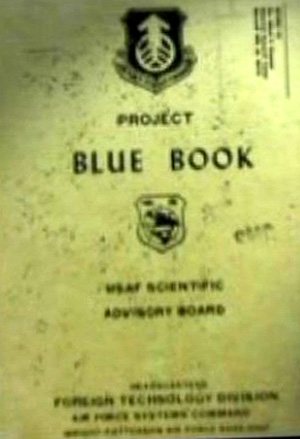
Cover of an actual Project Blue Book report
That said, to give Damon some plausible deniability to this
scenario, please note that — in his posting on Twitter — Lindelof said that
“Tomorrowland” is not about ALIENS. At no time does Damon say that
this December 2014 Walt Disney Pictures release isn’t investigating the
possible existence of unidentified flying objects.
Okay. That’s a fine distinction to make. But it is worth
noting.
It’s also worth noting here that — right after he graduated
from the California Institute of the Arts — Brad Bird’s very first job in
animation was at Walt Disney Studios. Where Brad worked (albeit briefly) on
WDAS’s 1981 release, “The Fox and the Hound
.”

Brad Bird behind the camera onset for “Mission: Impossible — Ghost
Protocol.” Copyright 2011 Paramount Pictures. All rights reserved
And given what Walt Disney Productions was like back during
those pre-Michael Eisner days (i.e. a smallish movie studio whose best years
really seemed to be behind it. A sleepy collection of 1940s-era administrative
buildings & soundstages hidden behind high walls in the quiet corner of
Burbank) … It’s not all hard to imagine that a young Brad Bird might have spent
a lot of his free time wandering the halls of Walt Disney Animation Studios.
Maybe opening a few closets and coming across a couple of bankers boxes just like the one that he & Damon Tweeted pictures
of back in late January.
More to the point, Brad did actually know Ward. In the
foreword that Bird wrote for Amid Amidi’s yet-to-be-released biography of
Kimball, “Full Steam Ahead: The Life and Art of Ward Kimball” (Chronicle
Books, Summer 2013), he mentions that …
Over the years I saw Kimball at various events and talked to
him many times …
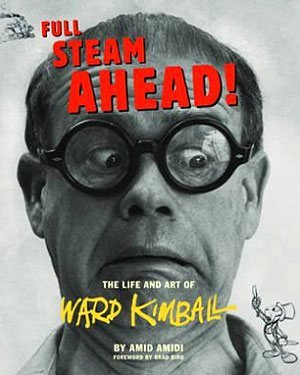
Copyright 2013 Chronicles Books. All rights reserved
So who knows? Maybe Ward himself told Brad about Disney’s
never-produced “UFOs are real” television show? And maybe Bird then
shared this story with Lindelof?
Either way, given the specific items that Walt Disney
Archives director Becky Cline spotted in that bankers box as well as that Sean
Bailey / long lost WED box story that Matthew Jackson shared with Blastr readers back in October of last year,
I’m thinking that — at this point — the evidence at hand strongly suggests that this
soon-to-begin-shooting George Clooney movie is going to be using this seemingly
forgotten, fantastic piece of Walt Disney Company history as the jumping-off
point for a brand-new sci-fi adventure.
Of course, your mileage may vary. But what do you folks
think? Have I properly interpreted the clues that Damon & Brad have placed
before us? Or do you have a theory of your own what “1952 /
Tomorrowland” might be about?
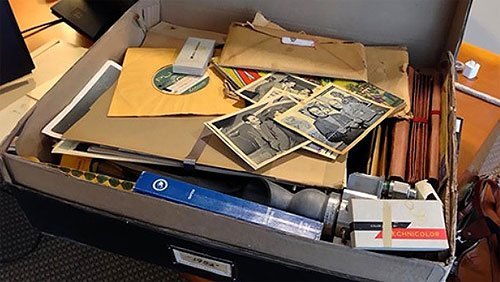
Copyright Disney Enterprises, Inc. All rights reserved
Your thoughts?
History
The Evolution and History of Mickey’s ToonTown

Disneyland in Anaheim, California, holds a special place in the hearts of Disney fans worldwide, I mean heck, it’s where the magic began after all. Over the years it’s become a place that people visit in search of memorable experiences. One fan favorite area of the park is Mickey’s Toontown, a unique land that lets guests step right into the colorful, “Toony” world of Disney animation. With the recent reimagining of the land and the introduction of Micky and Minnies Runaway Railway, have you ever wondered how this land came to be?
There is a fascinating backstory of how Mickey’s Toontown came into existence. It’s a tale of strategic vision, the influence of Disney executives, and a commitment to meeting the needs of Disney’s valued guests.
The Beginning: Mickey’s Birthdayland
The story of Mickey’s Toontown starts with Mickey’s Birthdayland at Walt Disney World’s Magic Kingdom. Opened in 1988 to celebrate Mickey Mouse’s 60th birthday, this temporary attraction was met with such overwhelming popularity that it inspired Disney executives to think bigger. The idea was to create a permanent, immersive land where guests could step into the animated world of Mickey Mouse and his friends.
In the early ’90s, Disneyland was in need of a refresh. Michael Eisner, the visionary leader of The Walt Disney Company at the time, had an audacious idea: create a brand-new land in Disneyland that would celebrate Disney characters in a whole new way. This was the birth of Mickey’s Toontown.
Initially, Disney’s creative minds toyed with various concepts, including the idea of crafting a 100-Acre Woods or a land inspired by the Muppets. However, the turning point came when they considered the success of “Who Framed Roger Rabbit.” This film’s popularity and the desire to capitalize on contemporary trends set the stage for Toontown’s creation.
From Concept to Reality: The Birth of Toontown
In 1993, Mickey’s Toontown opened its gates at Disneyland, marking the first time in Disney Park history where guests could experience a fully realized, three-dimensional world of animation. This new land was not just a collection of attractions but a living, breathing community where Disney characters “lived,” worked, and played.
Building Challenges: Innovative Solutions
The design of Mickey’s Toontown broke new ground in theme park aesthetics. Imagineers were tasked with bringing the two-dimensional world of cartoons into a three-dimensional space. This led to the creation of over 2000 custom-built props and structures that embodied the ‘squash and stretch’ principle of animation, giving Toontown its distinctiveness.
And then there was also the challenge of hiding the Team Disney Anaheim building, which bore a striking resemblance to a giant hotdog. The Imagineers had to think creatively, using balloon tests and imaginative landscaping to seamlessly integrate Toontown into the larger park.

Key Attractions: Bringing Animation to Life
Mickey’s Toontown featured several groundbreaking attractions. “Roger Rabbit’s Car Toon Spin,” inspired by the movie “Who Framed Roger Rabbit,” became a staple of Toontown, offering an innovative ride experience. Gadget’s Go-Coaster, though initially conceived as a Rescue Rangers-themed ride, became a hit with younger visitors, proving that innovative design could create memorable experiences for all ages.
Another crown jewel of Toontown is Mickey’s House, a walkthrough attraction that allowed guests to explore the home of Mickey Mouse himself. This attraction was more than just a house; it was a carefully crafted piece of Disney lore. The house was designed in the American Craftsman style, reflecting the era when Mickey would have theoretically purchased his first home in Hollywood. The attention to detail was meticulous, with over 2000 hand-crafted, custom-built props, ensuring that every corner of the house was brimming with character and charm. Interestingly, the design of Mickey’s House was inspired by a real home in Wichita Falls, making it a unique blend of real-world inspiration and Disney magic.
Mickey’s House also showcased Disney’s commitment to creating interactive and engaging experiences. Guests could make themselves at home, sitting in Mickey’s chair, listening to the radio, and exploring the many mementos and references to Mickey’s animated adventures throughout the years. This approach to attraction design – where storytelling and interactivity merged seamlessly – was a defining characteristic of ToonTown’s success.

Executive Decisions: Shaping ToonTown’s Unique Attractions
The development of Mickey’s Toontown wasn’t just about creative imagination; it was significantly influenced by strategic decisions from Disney executives. One notable input came from Jeffrey Katzenberg, who suggested incorporating a Rescue Rangers-themed ride. This idea was a reflection of the broader Disney strategy to integrate popular contemporary characters and themes into the park, ensuring that the attractions remained relevant and engaging for visitors.
In addition to Katzenberg’s influence, Frank Wells, the then-President of The Walt Disney Company, played a key role in the strategic launch of Toontown’s attractions. His decision to delay the opening of “Roger Rabbit’s Car Toon Spin” until a year after Toontown’s debut was a calculated move. It was designed to maintain public interest in the park by offering new experiences over time, thereby giving guests more reasons to return to Disneyland.
These executive decisions highlight the careful planning and foresight that went into making Toontown a dynamic and continuously appealing part of Disneyland. By integrating current trends and strategically planning the rollout of attractions, Disney executives ensured that Toontown would not only capture the hearts of visitors upon its opening but would continue to draw them back for new experiences in the years to follow.
Global Influence: Toontown’s Worldwide Appeal
The concept of Mickey’s Toontown resonated so strongly that it was replicated at Tokyo Disneyland and influenced elements in Disneyland Paris and Hong Kong Disneyland. Each park’s version of Toontown maintained the core essence of the original while adapting to its cultural and logistical environment.
Evolution and Reimagining: Toontown Today
As we approach the present day, Mickey’s Toontown has recently undergone a significant reimagining to welcome “Mickey & Minnie’s Runaway Railway” in 2023. This refurbishment aimed to enhance the land’s interactivity and appeal to a new generation of Disney fans, all while retaining the charm that has made ToonTown a beloved destination for nearly three decades.

Dive Deeper into ToonTown’s Story
Want to know more about Mickey’s Toontown and hear some fascinating behind-the-scenes stories, then check out the latest episode of Disney Unpacked on Patreon @JimHillMedia. In this episode, the main Imagineer who worked on the Toontown project shares lots of interesting stories and details that you can’t find anywhere else. It’s full of great information and fun facts, so be sure to give it a listen!
History
Unpacking the History of the Pixar Place Hotel

Pixar Place Hotel, the newly unveiled 15-story tower at the Disneyland Resort, has been making waves in the Disney community. With its unique Pixar-themed design, it promises to be a favorite among visitors.
However, before we delve into this exciting addition to the Disneyland Resort, let’s take a look at the fascinating history of this remarkable hotel.
The Emergence of the Disneyland Hotel
To truly appreciate the story of the Pixar Place Hotel, we must turn back the clock to the early days of Disneyland. While Walt Disney had the visionary ideas and funding to create the iconic theme park, he faced a challenge when it came to providing accommodations for the park’s visitors. This is where his friend Jack Wrather enters the picture.
Jack Wrather, a fellow pioneer in the television industry, stepped in to assist Walt Disney in realizing his dream. Thanks to the success of the “Lassie” TV show produced by Wrather’s company, he had the financial means to build a hotel right across from Disneyland.
The result was the Disneyland Hotel, which opened its doors in October 1955. Interestingly, the early incarnation of this hotel had more of a motel feel than a hotel, with two-story buildings reminiscent of the roadside motels popular during the 1950s. The initial Disneyland Hotel consisted of modest structures that catered to visitors looking for affordable lodging close to the park. While the rooms were basic, it marked the beginning of something extraordinary.
The Evolution: From Emerald of Anaheim to Paradise Pier
As Disneyland’s popularity continued to soar, so did the demand for expansion and improved accommodations. In 1962, the addition of an 11-story tower transformed the Disneyland Hotel, marking a significant transition from a motel to a full-fledged hotel.
The addition of the 11-story tower elevated the Disneyland Hotel into a more prominent presence on the Anaheim skyline. At the time, it was the tallest structure in all of Orange County. The hotel’s prime location across from Disneyland made it an ideal choice for visitors. With the introduction of the monorail linking the park and the hotel, accessibility became even more convenient. Unique features like the Japanese-themed reflecting pools added to the hotel’s charm, reflecting a cultural influence that extended beyond Disney’s borders.
Japanese Tourism and Its Impact
During the 1960s and 1970s, Disneyland was attracting visitors from all corners of the world, including Japan. A significant number of Japanese tourists flocked to Anaheim to experience Walt Disney’s creation. To cater to this growing market, it wasn’t just the Disneyland Hotel that aimed to capture the attention of Japanese tourists. The Japanese Village in Buena Park, inspired by a similar attraction in Nara, Japan, was another significant spot.
These attractions sought to provide a taste of Japanese culture and hospitality, showcasing elements like tea ceremonies and beautiful ponds with rare carp and black swans. However, the Japanese Village closed its doors in 1975, likely due to the highly competitive nature of the Southern California tourist market.
The Emergence of the Emerald of Anaheim
With the surge in Japanese tourism, an opportunity arose—the construction of the Emerald of Anaheim, later known as the Disneyland Pacific Hotel. In May 1984, this 15-story hotel opened its doors.
What made the Emerald unique was its ownership. It was built not by The Walt Disney Company or the Oriental Land Company (which operated Tokyo Disneyland) but by the Tokyu Group. This group of Japanese businessmen already had a pair of hotels in Hawaii and saw potential in Anaheim’s proximity to Disneyland. Thus, they decided to embark on this new venture, specifically designed to cater to Japanese tourists looking to experience Southern California.
Financial Challenges and a Changing Landscape
The late 1980s brought about two significant financial crises in Japan—the crash of the NIKKEI stock market and the collapse of the Japanese real estate market. These crises had far-reaching effects, causing Japanese tourists to postpone or cancel their trips to the United States. As a result, reservations at the Emerald of Anaheim dwindled.
To adapt to these challenging times, the Tokyu Group merged the Emerald brand with its Pacific hotel chain, attempting to weather the storm. However, the financial turmoil took its toll on the Emerald, and changes were imminent.
The Transition to the Disneyland Pacific Hotel
In 1995, The Walt Disney Company took a significant step by purchasing the hotel formerly known as the Emerald of Anaheim for $35 million. This acquisition marked a change in the hotel’s fortunes. With Disney now in control, the hotel underwent a name change, becoming the Disneyland Pacific Hotel.
Transformation to Paradise Pier
The next phase of transformation occurred when Disney decided to rebrand the hotel as Paradise Pier Hotel. This decision aligned with Disney’s broader vision for the Disneyland Resort.
While the structural changes were limited, the hotel underwent a significant cosmetic makeover. Its exterior was painted to complement the color scheme of Paradise Pier, and wave-shaped crenellations adorned the rooftop, creating an illusion of seaside charm. This transformation was Disney’s attempt to seamlessly integrate the hotel into the Paradise Pier theme of Disney’s California Adventure Park.
Looking Beyond Paradise Pier: The Shift to Pixar Place
In 2018, Disneyland Resort rebranded Paradise Pier as Pixar Pier, a thematic area dedicated to celebrating the beloved characters and stories from Pixar Animation Studios. As a part of this transition, it became evident that the hotel formally known as the Disneyland Pacific Hotel could no longer maintain its Paradise Pier theme.
With Pixar Pier in full swing and two successful Pixar-themed hotels (Toy Story Hotels in Shanghai Disneyland and Tokyo Disneyland), Disney decided to embark on a new venture—a hotel that would celebrate the vast world of Pixar. The result is Pixar Place Hotel, a 15-story tower that embraces the characters and stories from multiple Pixar movies and shorts. This fully Pixar-themed hotel is a first of its kind in the United States.
The Future of Pixar Place and Disneyland Resort
As we look ahead to the future, the Disneyland Resort continues to evolve. The recent news of a proposed $1.9 billion expansion as part of the Disneyland Forward project indicates that the area surrounding Pixar Place is expected to see further changes. Disneyland’s rich history and innovative spirit continue to shape its destiny.
In conclusion, the history of the Pixar Place Hotel is a testament to the ever-changing landscape of Disneyland Resort. From its humble beginnings as the Disneyland Hotel to its transformation into the fully Pixar-themed Pixar Place Hotel, this establishment has undergone several iterations. As Disneyland Resort continues to grow and adapt, we can only imagine what exciting developments lie ahead for this iconic destination.
If you want to hear more stories about the History of the Pixar Place hotel, check our special edition of Disney Unpacked over on YouTube.
Stay tuned for more updates and developments as we continue to explore the fascinating world of Disney, one story at a time.
History
From Birthday Wishes to Toontown Dreams: How Toontown Came to Be

In the latest release of Episode 4 of Disney Unpacked, Len and I return, joined as always by Disney Imagineering legend, Jim Shull. This two-part episode covers all things Mickey’s Birthday Land and how it ultimately led to the inspiration behind Disneyland’s fan-favorite land, “Toontown”. But let’s not get ahead of ourselves here. It all starts in the early days at Disneyland.
Early Challenges in Meeting Mickey
Picture this: it’s the late 1970s and early 1980s, and you’re at Disneyland. You want to meet the one and only Mickey Mouse, but there’s no clear way to make it happen. You rely on Character Guides, those daily printed sheets that point you in Mickey’s general direction. But let’s be honest, it was like finding a needle in a haystack. Sometimes, you got lucky; other times, not so much.

Mickey’s Birthdayland: A Birthday Wish that Came True
Fast forward to the late 1980s. Disney World faced a big challenge. The Disney-MGM Studios Theme Park was under construction, with the company’s marketing machine in full swing, hyping up the opening of Walt Disney World’s third theme park, MGM Studios, in the Spring of 1989. This extensive marketing meant that many people were opting to postpone their family’s next trip to Walt Disney World until the following year. Walt Disney World needed something compelling to motivate guests to visit Florida in 1988, the year before Disney MGM Studios opened.
Enter stage left, Mickey’s Birthdayland. For the first time ever, an entire land was dedicated to a single character – and not just any character, but the mouse who started it all. Meeting Mickey was no longer a game of chance; it was practically guaranteed.

The Birth of Birthdayland: Creative Brilliance Meets Practicality
In this episode, we dissect the birth of Mickey’s Birthdayland, an initiative that went beyond celebrating a birthday. It was a calculated move, driven by guest feedback and a need to address issues dating back to 1971. Imagineers faced the monumental task of designing an experience that honored Mickey while efficiently managing the crowds. This required the perfect blend of creative flair and logistical prowess – a hallmark of Disney’s approach to theme park design.
Evolution: From Birthdayland to Toontown
The success of Mickey’s Birthdayland was a real game-changer, setting the stage for the birth of Toontown – an entire land that elevated character-centric areas to monumental new heights. Toontown wasn’t merely a spot to meet characters; it was an immersive experience that brought Disney animation to life. In the episode, we explore its innovative designs, playful architecture, and how every nook and cranny tells a story.

Impact on Disney Parks and Guests
Mickey’s Birthdayland and Toontown didn’t just reshape the physical landscape of Disney parks; they transformed the very essence of the guest experience. These lands introduced groundbreaking ways for visitors to connect with their beloved characters, making their Disney vacations even more unforgettable.
Beyond Attractions: A Cultural Influence
But the influence of these lands goes beyond mere attractions. Our episode delves into how Mickey’s Birthdayland and Toontown left an indelible mark on Disney’s culture, reflecting the company’s relentless dedication to innovation and guest satisfaction. It’s a journey into how a single idea can grow into a cherished cornerstone of the Disney Park experience.

Unwrapping the Full Story of Mickey’s Birthdayland
Our two-part episode of Disney Unpacked is available for your viewing pleasure on our Patreon page. And for those seeking a quicker Disney fix, we’ve got a condensed version waiting for you on our YouTube channel. Thank you for being a part of our Disney Unpacked community. Stay tuned for more episodes as we continue to “Unpack” the fascinating world of Disney, one story at a time.
-
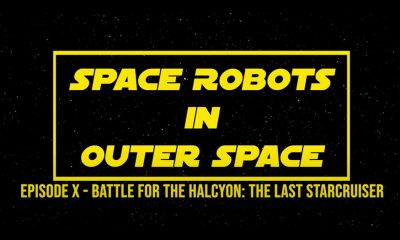
 News & Press Releases12 months ago
News & Press Releases12 months agoStar Wars Spoof: Space Robots in Outer Space Ep X: Battle for the Halcyon: The Last Starcruiser
-

 History11 months ago
History11 months ago31 Long-Gone Rides, Shows & Attractions at Disney-MGM (Hollywood Studios)
-

 News & Press Releases8 months ago
News & Press Releases8 months agoDisney Will Bring D23: The Ultimate Disney Fan Event to Anaheim, California in August 2024
-

 History3 months ago
History3 months agoFrom Birthday Wishes to Toontown Dreams: How Toontown Came to Be
-

 Theme Parks & Themed Entertainment11 months ago
Theme Parks & Themed Entertainment11 months agoFrom Aladdin to Indy – How Did We Get an Indiana Jones Stage Show at Disneyland?
-

 Theme Parks & Themed Entertainment12 months ago
Theme Parks & Themed Entertainment12 months agoHow Did We Get “Aladdin’s Oasis” at Disneyland?
-

 Theme Parks & Themed Entertainment10 months ago
Theme Parks & Themed Entertainment10 months agoWhen WDW Had a Racetrack – The Creation of the Walt Disney World Speedway
-

 Film & Movies10 months ago
Film & Movies10 months ago“Indiana Jones and the Search for Indiana Jones”








